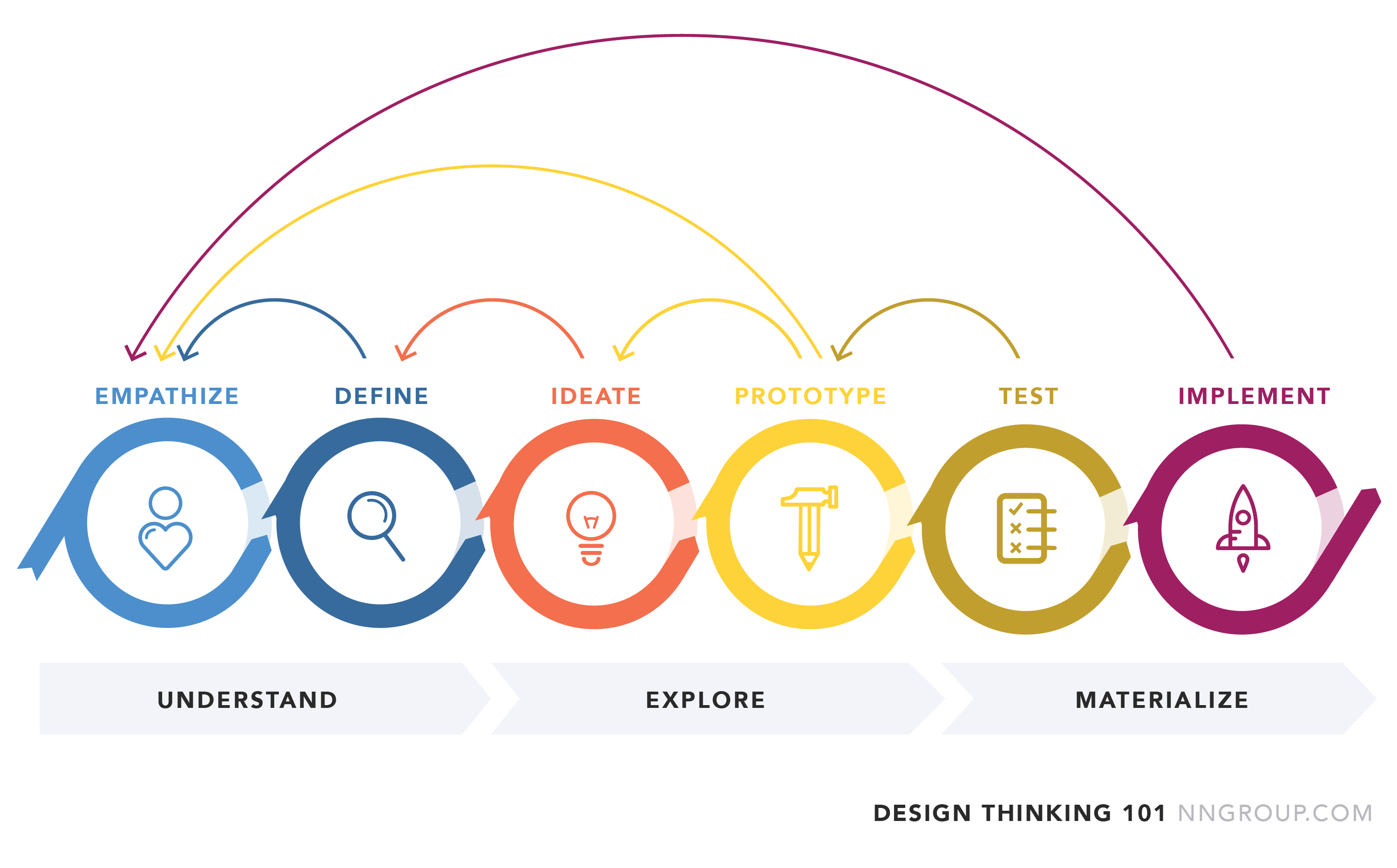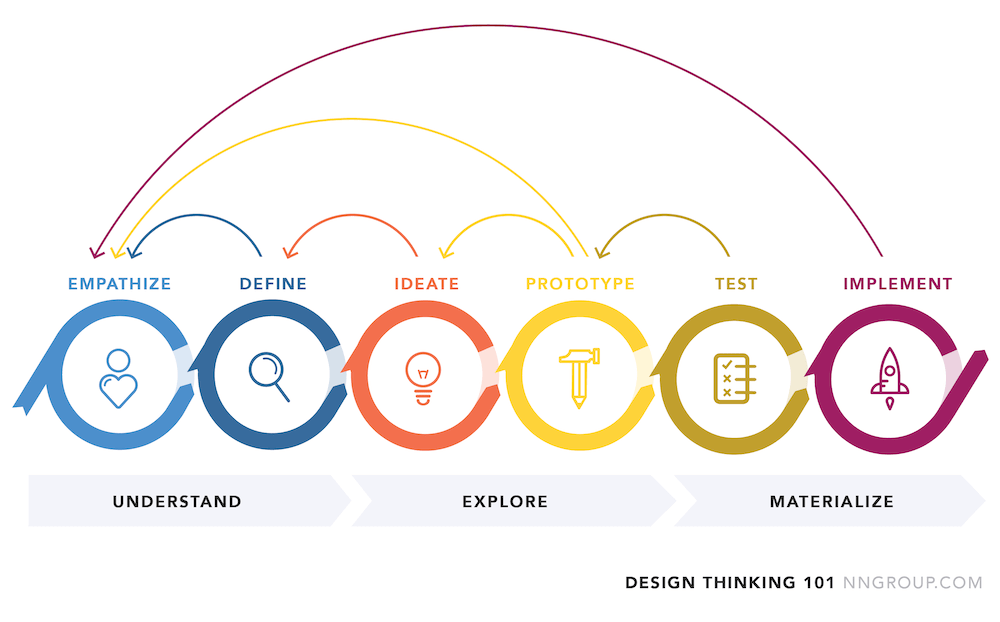Here are some strategies to make sure PwDs are not excluded.

Note that this article does not address the question “should you be using Design Thinking at all?” — there are two very distinct camps on opposite ends of the spectrum on that question. Each camp is attached to their positions almost as if they were religious doctrine as is evidenced by the following two headlines:
- Design Thinking is BS (Fast Company also refers to it as a “cult”)
- Why Design Thinking Works (HBR)
I will repeat something that I say at least once a week to someone on one of my product teams.
If you decide to do something, it HAS to be accessible.
Features and methodologies are a choice. Accessibility is not. If you choose to use design thinking, there are two crucial things to consider regarding disabilities:
- Are you thinking about the needs of your users with disabilities?
- Are you thinking about the needs of your design thinking participants with disabilities?
How do you identify the needs of your users with disabilities
Under the universal/inclusive design doctrine, you design for all users and, therefore, do not call out the needs of the users with disabilities.
I think if you are in a group where all are thoroughly trained in those methods, that approach works. However, more often than not, designers at any given company come from varying backgrounds with differing levels of training and/or certifications in areas related to accessibility.
Stories are universal. They are a powerhouse mechanism that takes abstract concepts and makes them stick in people’s memories because they trigger “all the feels” which is what is necessary to get things put into storage. That’s why, for accessibility, I prefer specific thought processes and research around what users with disabilities need. That approach has been vastly more effective at the companies I have worked for. For what it’s worth, my storytelling approach is a cross between what I learned about litigation in law school, and what I was taught by Amy Posey of SuperMegaBoss as part of a “pitching tech ideas” session that VMware does with her twice a year.
- Arguing a court case is a pitch
- Selling a new product idea is a pitch
- Teaching people to care about accessibility — you guessed it, a pitch.
“What about users with dexterity issues?” is not a story. There are no emotions or feelings.
“My cousin George has cerebral palsy and has trouble picking things up. He would love to use this product except …” is a story that can be turned into a pitch.
Stage 1: Empathize — Research Your Users’ Needs
Do you have users with disabilities? Do you have personas with disabilities? If the answer to either of those questions is no, why not? “I don’t have users with disabilities” is NEVER a valid statement. Users with disabilities are potentially 1/5th of your population.
- Either you have users with disabilities and you just don’t know it because you aren’t asking the right questions, or;
- You don’t have users with disabilities because your product is so inaccessible people who need assistive technology can’t become users even if they wanted to
Both of these are easily fixable. Your organization just has to care enough to take the necessary actions.
Stage 2: Define — State Your Users’ Needs and Problems
Take a few random disabilities, preferably by talking to people with those disabilities, and figure out where your product would cause those individual barriers. If your product has a particular target audience, try to focus on disabilities that are disproportionate to those groups. Elderly? Vision loss, hearing loss, and dexterity issues. Children? Learning differences.
Consider disability “co-morbidities,” which is a horrible phrase that means “things that commonly go along with a disability” — mental health challenges, obesity, and lower socioeconomic status are the most common disability co-morbidities. Remember that disability is intersectional.
A disabled, queer, woman of color is going to have very different product challenges than a disabled cisgender white man, even if they have the same disability.
Stage 3: Ideate — Challenge Assumptions and Create Ideas and Stage 4: Prototype — Start to Create Solutions.
Take those barriers you identified in the previous step and start to brainstorm ideas that would help eliminate them. Do not constrain yourself with conventional thinking. Creative ideas for removing accessibility barriers abound.
- Personalization is probably the best curb cut feature that can be implemented to improve the experience of people without disabilities, but drastically improve the experience of people with disabilities.
- Removal of friction points is a close second.
Stage 5: Test — Try Your Solutions Out and Stage 6: Launch
Make sure that your solutions are tested with both people with and without disabilities.
Make sure your physical space and design thinking event are accessible themselves
Smashing Magazine, which has an outstanding accessibility reputation, seriously dropped the ball with its “Five Design Thinking Workshop Warm-ups.” Here were some of their ideas, and me explaining why they are mostly inaccessible.
- Smashing: Draw a vase? Sheri: How can you do that well if you can’t see or hold a pen comfortably?
- Smashing: Grandma, Tiger, Ninja (effectively millennial Rock, Paper, Scissors) Sheri: Grandma’s have a hunched back? Seriously? I don’t even want to think about HR’s reaction if you flash the “Grandma” sign to someone who is actually a grandmother. A lot of design thinking exercises are “whole body” — you just have to remember that not everyone’s body is whole.
- Smashing: Zombie Cats (team naming and charades). Sheri: another full-body “acting out” exercise.
There is a great list of vision loss-friendly icebreakers here.
How do you make your design thinking event accessible?
Step 1: Follow the best practices for accessible teleconferences I’ve written about here.
Step 2: Don’t use inaccessible tools like Miro, Figma, Acuity, or Dovetail (just to name a few).
Step 3: If you need to use a whiteboarding solution, use Jamboard or Microsoft Whiteboard. Pair up anyone who might not be able to use it with a buddy who can help turn their ideas into input that others can see and describe information for them. Setup a breakout room in Zoom or some other accessible form of communication for the person and the buddy if need be.
Step 4: Do make sure you include people with disabilities in the decision-making process and ask them what they need to be at their best. It’s an individual thing — some people might want help. Others with the exact same disability might prefer to work on their own.
Like many things in this world, accessibility doesn’t come naturally.
- It has to be deliberately thought of;
- and thoughtfully implemented (i.e. specific steps need to be taken to make sure everyone can participate)
I know that seems like a lot of work. Once you’ve done it a couple of times, it will come more naturally. Also, it’s far less work than excluding the POV of your co-workers/users with disabilities and making recommendations that result in an incomplete answer. When your approach only considers 82 % of your users, you may very well have to do everything a second time. And, the resulting product can’t legally be bought or used by the public sector. Rework is incredibly costly in a time where we should be working smarter.

0 comments on “Accessibility and Design Thinking don’t work together automatically”